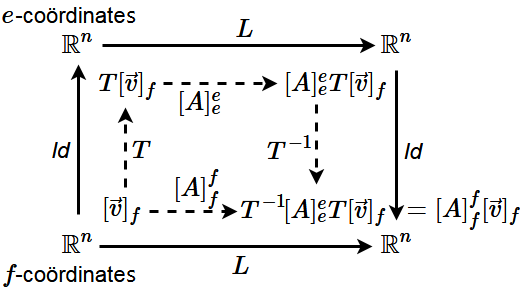Linear mappings: Matrices and coordinate transformations
 Transition to a different coordinate system
Transition to a different coordinate system
We will generalize the introductory example to the \(n\)-dimensional Euclidean space \(\mathbb{R}^n\).
The unit vectors \(\vec{e}_1=\cv{1\\0\\ \vdots \\ \vdots \\ 0}, \vec{e}_2=\cv{0\\1\\0\\ \vdots \\ 0} \ldots, \vec{e}_n=\cv{0\\ \vdots \\ \vdots \\ 0 \\ 1} \) belong to a choice of a coordinate system in the Euclidean space \(\mathbb{E}^n\). But you can also select a different coordinate system. In fact, you define then axis vectors \(\vec{f}_{\!1}, \vec{f}_{\!2}, \ldots, \vec{f}_{\!n}\) along new axes. Let \[\begin{aligned} \vec{f}_{\!1} &= c_{11}\vec{e}_1+c_{21}\vec{e}_2+\cdots + c_{n1}\vec{e}_n\\ \vec{f}_{\!2}&= c_{12}\vec{e}_1+c_{22}\vec{e}_2+\cdots + c_{n2}\vec{e}_n\\ &\;\;\vdots \\ \vec{f}_{\!n} &= c_{1n}\vec{e}_1+c_{2n}\vec{e}_2+\cdots + c_{nn}\vec{e}_n \end{aligned}\] Then the transformation matrix \([\textit{Id}]_e^f\) is defined by \[[\textit{Id}\,]_e^f=\matrix{c_{11} & c_{12} & \cdots & c_{1n}\\ c_{21} & c_{22} & \cdots & c_{2n} \\ \vdots & \vdots & \ddots & \vdots\\ c_{n1} & c_{n2} & \cdots & c_{nn}}\] Make sure that you take the transformed form of the number scheme in the linear combinations of the \(e\) vectors.
Each vector \(\vec{v}\) in \(\mathbb{E}^n\) can be written as linear combination \([\vec{v}]_e\) of the unit vectors \(\vec{e}_1, \vec{e}_2, \ldots, \vec{e}_n\). We write \[[\vec{v}]_e = \alpha_1\vec{e}_1+\alpha_2\vec{e}_2+\cdots + \alpha_n\vec{e}_n\] We can also do the \(\vec{f}_{\!1}, \vec{f}_{\!2}, \ldots, \vec{f}_{\!n}\) : \[[\vec{v}]_f = \beta_1\vec{f}_{\!1}+\beta_2\vec{f}_{\!2}+\cdots + \beta_n\vec{f}_{\!n}\] Naturally we ask ourselves what connection there is between the \(\alpha\)-s and \(\beta\)-s. Well:
\[\cv{\alpha_1\\ \vdots \\ \alpha_n}= \matrix{c_{11} & \cdots & c_{1n}\\ \vdots & \ddots & \vdots \\ c_{n1} & \cdots & c_{nn}}\!\cv{\beta_1 \\ \vdots\\ \beta_n}\] In short notation: \[[\vec{v}]_e = [\textit{Id}\,]_e^f\,[\vec{v}]_f\]The transformation matrix is be definition invertible and we denote this inverse by \([\textit{Id}\,]_f^e\). In other words \[[\vec{v}]_f = [\textit{Id}\,]_f^e\, [\vec{v}]_e = \left([\textit{Id}\,]_e^f\right)^{-1}[\vec{v}]_e\]
Let \(L\) be a linear mapping from \(\mathbb{R}^n\) to \(\mathbb{R}^n\). We already know that it is a matrix mapping when we choose of a coordinate system, that is, that there is a matrix \([A]_e^e\) such that \(L(\vec{v}) = [A]_e^e\,[\vec{v}]_e\). Here we have used the labels \(e\) to indicate the selected coordinate system with corresponding unit vectors \(\vec{e}_1,\ldots, \vec{e}_n\). The same linear mapping \(L\) can also be described with respect to another coordinate system with axis vectors \(\vec{f}_{\!1},\ldots, \vec{f}_{\!n}\) by means of a matrix \([A]_f^f\). The following theorem describes the relationship between the two matrices.
In the transition from \(e\)-coordinates to \(f\)-coordinates applies \[[A]_f^f=[\textit{Id}\,]_f^e\cdot[A]_e^e\cdot[\textit{Id}\,]_e^f\tiny.\] If we abbreviate the transformation matrix \([\textit{Id}\,]_e^f\), which describes the vectors \(\vec{f}_{\!1}, \ldots \vec{f}_{\!n}\) as linear combinations of the vectors \(\vec{e}_1, \ldots, \vec{e}_n\), with the letter \(T\), we have \[[A]_f^f=T^{-1}\cdot [A]_e^e\cdot T\] The diagram below illustrates the coordinate transformation.

What is the matrix \([L]_e^e\) in terms of the unit vectors \(\vec{e}_1=\cv{1\\0}\) and \(\vec{e}_2=\cv{0\\1}\)?
What is the matrix \([L]_f^f\) in \(f\)-coordinates where \(\vec{f}_{\!1}=\matrix{1 \\ 2 \\ }\) and \(\vec{f}_{\!2}=\matrix{-3 \\ -5 \\ }\)?
\([L]_f^f={}\) \(\matrix{-23 & 61 \\ -9 & 24 \\ }\).
The first equality follows from \[L\cv{1\\ 0}=\cv{2\\1},\quad L\cv{0\\ 1}=\cv{1\\-1}\] by placing these image vectors as columns in the matrix.
The transformation matrix \(T\) from \(f\)-coordinates to \(e\)-coordinates is given by \[T=\matrix{1 & -3 \\ 2 & -5 \\ }\tiny.\] We also need the inverse of this transformation matrix. This can be calculated using the general formula for an inverse \(2\times 2\) matrix, but perhaps better by the below row reduction process \[\begin{aligned}\left(\begin{array}{rr|rr} 1&-3&1&0\\2&-5&0&1\end{array}\right)&\sim\left(\begin{array}{rr|rr} 1&-3&1&0\\0&1&-2&1\end{array}\right)&{\blue{\begin{array}{c}\phantom{x}\\R_2-2R_1\end{array}}}\\\\ &\sim\left(\begin{array}{rr|rr} 1&0&-5&3\\0&1&-2&1\end{array}\right)&{\blue{\begin{array}{c}R_1+3R_2\\\phantom{x}\end{array}}}\end{aligned}\] We read: \[T^{-1} = \matrix{-5 & 3 \\ -2 & 1 \\ }\]
Then:
\[\begin{aligned} {[L]}_f^f &=T^{-1}\cdot [L]_e^e \cdot T\\ \\ &= \matrix{-5 & 3 \\ -2 & 1 \\ } \matrix{2 & 1\\ 1 & -1} \matrix{1 & -3 \\ 2 & -5 \\ } \\ \\ &= \matrix{-7 & -8 \\ -3 & -3 \\ } \matrix{1 & -3 \\ 2 & -5 \\ }\\ \\ &=\matrix{-23 & 61 \\ -9 & 24 \\ }\end{aligned}\]


